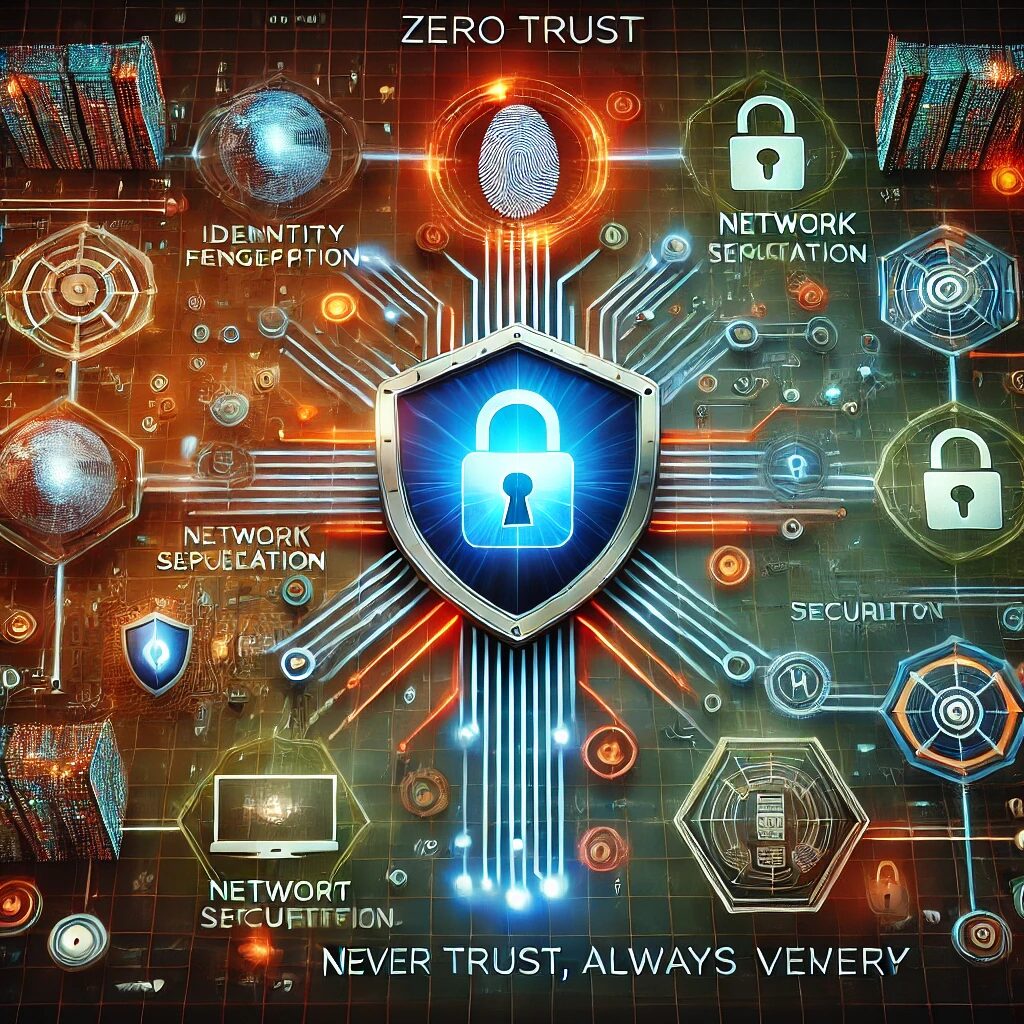Concept of Zero Trust
Zero Trust is a security model that operates on the principle of “never trust, always verify.” This paradigm shift from the traditional perimeter-based security model, which assumes everything inside an organization’s network is trustworthy, to one that treats every interaction, both inside and outside the network, as a potential threat. Zero Trust assumes that threats could be both external and internal, and thus, no entity, whether it is a user, device, or application, should be inherently trusted.
Core Principles of Zero Trust
- Verify Explicitly: Always authenticate and authorize based on all available data points, including user identity, location, device health, service or workload, data classification, and anomalies.
- Use Least Privilege Access: Limit user and application permissions to only what is necessary, reducing the risk if an account or device is compromised.
- Assume Breach: Design the system in a way that limits the blast radius and the impact of potential breaches, and continuously monitor systems to improve detection and response.
Implementing Zero Trust: Practices and Examples
- Identity and Access Management (IAM):
- Multi-Factor Authentication (MFA): Require multiple forms of verification to reduce the risk of unauthorized access.
- Single Sign-On (SSO): Simplifies authentication for users while allowing centralized control over access policies.
- Network Segmentation:
- Microsegmentation: Dividing the network into smaller, isolated segments to limit lateral movement by an attacker.
- Software-Defined Perimeter (SDP): Create boundaries around critical resources and ensure they are accessible only through authenticated and authorized entities.
- Device Security:
- Endpoint Detection and Response (EDR): Continuously monitor and respond to security threats on endpoints.
- Mobile Device Management (MDM): Ensure that only compliant devices can access corporate resources.
- Application Security:
- Container Security: Protect containerized applications through runtime protection, vulnerability management, and compliance monitoring.
- Secure Access Service Edge (SASE): Combine networking and security functions in a cloud-native architecture.
- Data Security:
- Data Loss Prevention (DLP): Monitor and protect sensitive data from being lost, misused, or accessed by unauthorized users.
- Encryption: Use encryption for data at rest and in transit to ensure confidentiality and integrity.
Role-Based Access Control (RBAC) in Zero Trust
RBAC is integral to implementing a Zero Trust model because it helps enforce the principle of least privilege by restricting access based on the user’s role within an organization. Here’s how RBAC fits into Zero Trust:
- Defining Roles: Create roles based on job functions and assign permissions accordingly. Each role should have the minimum necessary access rights required to perform its duties.
- Assigning Permissions: Associate users with roles, ensuring that permissions are managed centrally and adjusted as roles evolve.
- Continuous Monitoring: Regularly audit roles and permissions to ensure they align with current job functions and remove unnecessary privileges.
- Dynamic Access Control: Incorporate contextual data (e.g., time of access, location, device health) into access decisions, ensuring that even within a role, access is granted based on real-time risk assessment.
Example of Zero Trust Implementation
Organization: A Mid-Sized Enterprise
- User Authentication:
- Implemented MFA for all employees, ensuring that access requires both a password and a verification code from a mobile app.
- Integrated SSO to streamline access to multiple services with centralized identity management.
- Network Security:
- Adopted microsegmentation, isolating critical financial systems from other parts of the network.
- Deployed an SDP to provide secure access to sensitive data only to authenticated and authorized users.
- Endpoint Management:
- Used EDR solutions to monitor and protect endpoints from threats continuously.
- Enforced MDM policies, allowing only compliant devices to connect to the network.
- Application and Data Security:
- Utilized container security solutions to ensure that applications running in containers are secure.
- Deployed DLP tools to monitor and control the movement of sensitive data across the network.
- RBAC Integration:
- Defined clear roles such as “Finance Manager,” “HR Assistant,” and “IT Admin,” each with specific permissions.
- Conducted quarterly audits to adjust roles and permissions based on changes in job functions and business needs.
- Implemented dynamic access policies that adjust permissions based on contextual information, such as the user’s location and the time of access.
Conclusion
The Zero Trust model is a comprehensive approach to security that adapts to the evolving threat landscape by assuming that no entity, whether inside or outside the network, is trustworthy by default. By implementing practices such as robust IAM, network segmentation, endpoint security, application security, and integrating RBAC, organizations can significantly enhance their security posture, ensuring that access is granted based on stringent verification and the principle of least privilege.


